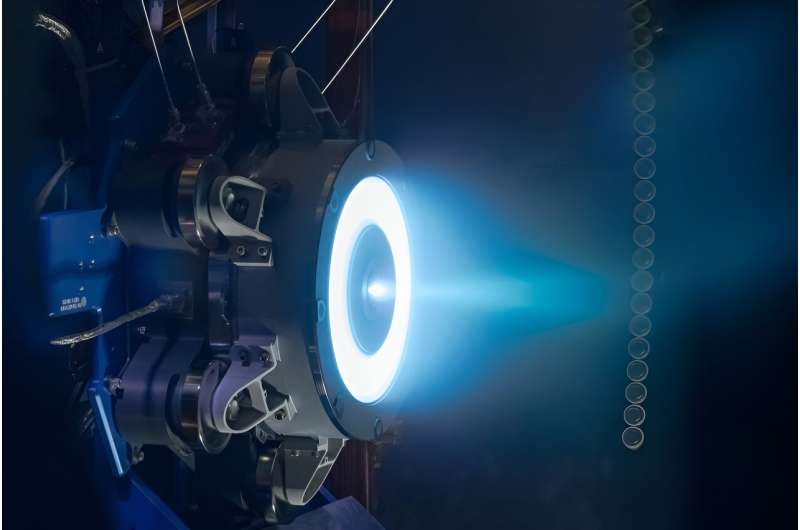
Copernical Team
Jurassic worlds might be easier to spot than modern Earth
 Might a tyrannosaur roam on Trappist-1e, a protoceratops on Proxima Centauri b, or a quetzalcoatlus on Kepler 1047c? Things may not have ended well for dinosaurs on Earth, but Cornell astronomers say the "light fingerprint" of the conditions that enabled them to emerge here - including abundant atmospheric oxygen - provides a crucial missing piece in our search for signs of life on planets orbit
Might a tyrannosaur roam on Trappist-1e, a protoceratops on Proxima Centauri b, or a quetzalcoatlus on Kepler 1047c? Things may not have ended well for dinosaurs on Earth, but Cornell astronomers say the "light fingerprint" of the conditions that enabled them to emerge here - including abundant atmospheric oxygen - provides a crucial missing piece in our search for signs of life on planets orbit NASA welcomes Netherlands as newest Artemis Accords signatory
 During a ceremony at the Dutch Ambassador's Residence in Washington on Wednesday, the Netherlands became the 31st country to sign the Artemis Accords. NASA Administrator Bill Nelson participated in the signing ceremony for the agency, and Netherlands Space Office (NSO) director Harm van de Wetering signed on behalf of the Netherlands.
NASA Deputy Administrator Pam Melroy and the following
During a ceremony at the Dutch Ambassador's Residence in Washington on Wednesday, the Netherlands became the 31st country to sign the Artemis Accords. NASA Administrator Bill Nelson participated in the signing ceremony for the agency, and Netherlands Space Office (NSO) director Harm van de Wetering signed on behalf of the Netherlands.
NASA Deputy Administrator Pam Melroy and the following Workshop to highlight NASA's support for mobility, in-space servicing
 NASA leadership, including Deputy Administrator Pam Melroy, will participate in a workshop on space mobility and in-space servicing on Tuesday, Nov. 7, at the University of Maryland in College Park.
Beginning at 8:30 a.m. EST, the Consortium for Space Mobility and ISAM Capabilities (COSMIC) workshop runs through Wednesday, Nov. 8. NASA announced the consortium in April, aiming to create a
NASA leadership, including Deputy Administrator Pam Melroy, will participate in a workshop on space mobility and in-space servicing on Tuesday, Nov. 7, at the University of Maryland in College Park.
Beginning at 8:30 a.m. EST, the Consortium for Space Mobility and ISAM Capabilities (COSMIC) workshop runs through Wednesday, Nov. 8. NASA announced the consortium in April, aiming to create a SwRI's Dr. Alan Stern conducts space research during suborbital spaceflight aboard Virgin Galactic's VSS Unity
 Dr. Alan Stern, a planetary scientist and associate vice president of Southwest Research Institute's Space Science Division, today flew aboard the Virgin Galactic commercial spaceship Unity on a suborbital space mission. During the roughly 60-minute mission, first mated to its carrier aircraft VMS Eve, and then horizontally launched into space, Stern tested equipment and trained for a future sub
Dr. Alan Stern, a planetary scientist and associate vice president of Southwest Research Institute's Space Science Division, today flew aboard the Virgin Galactic commercial spaceship Unity on a suborbital space mission. During the roughly 60-minute mission, first mated to its carrier aircraft VMS Eve, and then horizontally launched into space, Stern tested equipment and trained for a future sub High-power propulsion for gateway will be electric blue
 NASA's Glenn Research Center in Cleveland recently witnessed the vibrant blue glow of the Advanced Electric Propulsion System (AEPS) within its vacuum chamber during a critical phase of thruster qualification testing. This significant advancement in space technology reflects the culmination of efforts to create the most robust electric propulsion thruster to date. With a 12-kilowatt Hall thruste
NASA's Glenn Research Center in Cleveland recently witnessed the vibrant blue glow of the Advanced Electric Propulsion System (AEPS) within its vacuum chamber during a critical phase of thruster qualification testing. This significant advancement in space technology reflects the culmination of efforts to create the most robust electric propulsion thruster to date. With a 12-kilowatt Hall thruste Zephr raises $3.5M to bring next-gen GPS to major industries
 Zephr, a leading developer of next-generation GPS technologies, has announced a $3.5 million seed round led by Space Capital and First Spark Ventures as it officially launches a groundbreaking "networked GPS" solution to dramatically improve GPS accuracy and reliability, creating new economic opportunities for many current and emerging industries. The new funding will support Zephr's GTM strateg
Zephr, a leading developer of next-generation GPS technologies, has announced a $3.5 million seed round led by Space Capital and First Spark Ventures as it officially launches a groundbreaking "networked GPS" solution to dramatically improve GPS accuracy and reliability, creating new economic opportunities for many current and emerging industries. The new funding will support Zephr's GTM strateg Five-Year Deal for Sidus Space in Support of Lunar Operations
 Sidus Space, a company that operates within the sphere of Space and Data-as-a-Service, has recently secured a significant contract, marking a stride in its business trajectory. This contract, which is categorized as an Indefinite-Delivery/Indefinite-Quantity (IDIQ) agreement, will see Sidus Space deliver comprehensive support services to a US-owned entity that is actively engaged in commercial l
Sidus Space, a company that operates within the sphere of Space and Data-as-a-Service, has recently secured a significant contract, marking a stride in its business trajectory. This contract, which is categorized as an Indefinite-Delivery/Indefinite-Quantity (IDIQ) agreement, will see Sidus Space deliver comprehensive support services to a US-owned entity that is actively engaged in commercial l NASA's Lucy Spacecraft Discovers 2nd Asteroid During Dinkinesh Flyby
 On Nov. 1, NASA's Lucy spacecraft flew by not just its first asteroid, but its first two. The first images returned by Lucy reveal that the small main belt asteroid Dinkinesh is actually a binary pair.
"Dinkinesh really did live up to its name; this is marvelous," said Hal Levison, referring to the meaning of Dinkinesh in the Amharic language, "marvelous." Levison is principal investigator
On Nov. 1, NASA's Lucy spacecraft flew by not just its first asteroid, but its first two. The first images returned by Lucy reveal that the small main belt asteroid Dinkinesh is actually a binary pair.
"Dinkinesh really did live up to its name; this is marvelous," said Hal Levison, referring to the meaning of Dinkinesh in the Amharic language, "marvelous." Levison is principal investigator Norway inaugurates satellite launch site

Norway on Thursday joined the race to launch satellites from the European continent by inaugurating a new spaceport on the island of Andoya, north of the Arctic Circle.
Isar Aerospace said the "Andoya Spaceport" was to "become the first operational orbital spaceport in continental Europe to finalize the construction of the launch site."
It was inaugurated at a ceremony attended by Norway's Crown Prince Haakon nine months after the inauguration of the Esrange spaceport in neighboring Sweden.
As tensions have grown with Russia, depriving Europe of access to its cosmodromes and launchpads, the site seeks to help European countries strengthen their own capacity for putting small and medium-sized satellites into orbit.
The launch base, which eventually will have several launch pads, was built by Norwegian public company Andoya Space, on a site which until now has only been used for firing suborbital scientific experiment rockets.
Spectrum, a two-stage craft capable of carrying up to one metric ton and developed by the German start-up Isar Aerospace, is scheduled to be the first rocket to be launched from island which is located near the idyllic Lofoten archipelago.
Image: High-power thruster qualification testing for Gateway

The blue hue of the Advanced Electric Propulsion System (AEPS) is seen inside a vacuum chamber at NASA's Glenn Research Center in Cleveland during recent thruster qualification testing. This 12-kilowatt Hall thruster is the most powerful electric propulsion thruster in production, and it will be critical to future science and exploration missions at the moon and beyond.
The blue plume is a steady stream of ionized xenon gas ejected to produce low, highly efficient thrust. These electric propulsion systems accelerate spacecraft to extremely high speeds over time using only a fraction of the fuel chemical propulsion systems require, making electric propulsion an excellent choice for deep-space exploration and science missions.
Three AEPS thrusters will be mounted on the Power and Propulsion Element, a foundational component of Gateway. The small lunar space station is critical to the agency's Artemis missions that will help prepare for human missions to Mars. The Power and Propulsion Element will provide Gateway with power, high-rate communications, and allow it to maintain its unique orbit around the moon.
The AEPS thruster recently returned to NASA Glenn to continue qualification testing to certify the thrusters for flight.

